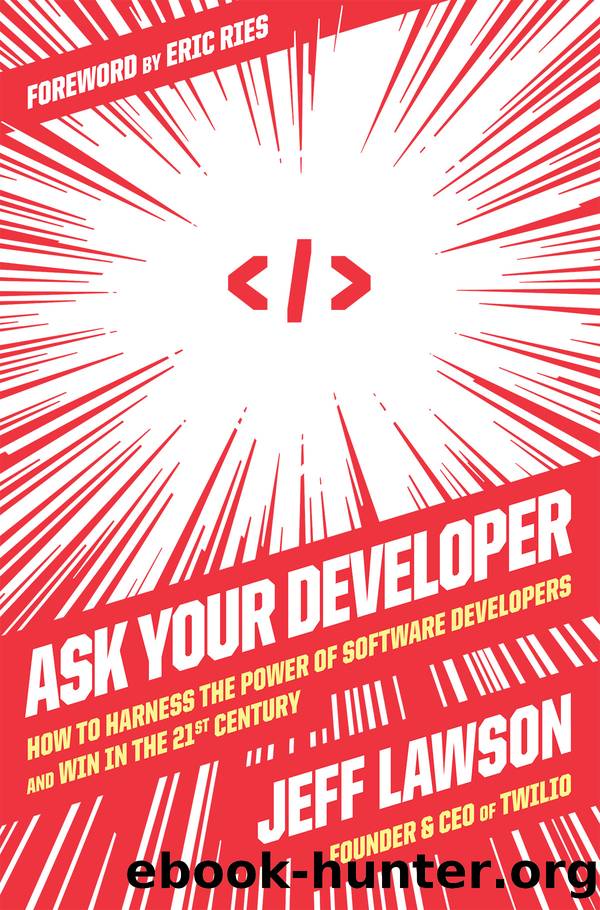Ask Your Developer by Jeff Lawson

Author:Jeff Lawson
Language: eng
Format: epub
Publisher: Harper Business
Published: 2021-01-12T00:00:00+00:00
Autonomy
Every human wants to feel empowered, and developers are no different. But even more so, as professionals they bring technology domain expertise thatâs valuable to the companies they work forâbut is often overlooked. The essence of autonomy is feeling trusted to make decisions. If someone else can just veto whatever decisions you make, then youâre not really all that autonomous. Of course, if you pull rank in a company, you can always make the decisions. But wise leaders who want their teams to feel trusted resist the temptation to overrule their teamsâ decisions, instead erring on the side of autonomy. Thatâs how I think about it.
But full autonomy can become counterproductive in a world where teams have lots of dependencies, and itâs tough to wrangle thousands of people off in their own land. By empowering developers, you are trusting them to do their jobs and giving them tools, but you also instate some guardrails and rules. This is more realistic than full autonomy, especially for an organization at scale. Especially when we do need a full R&D org to focus on things like incident reduction, security, stability, and more.
So instead of letting developers just run around and do whatever they want, autonomy actually has its basis in rules. Without guardrails, people wonât know how to make decisions, and leaders will tend to second-guess them constantly. By creating rules, you paradoxically set people freeâin the space between guardrails.
One of my favorite examples of this was from my high school. I was a member of my high schoolâs radio station, WBFH, known colloquially as âThe Biff.â Broadcasting at 360 watts, we were proudly metro Detroitâs most powerful high school radio station. Being on radio station staff meant we all had jobs, like those at a real radio station, and we each had a weekly two-hour show to host. My senior year of high school, I had the job of music director, and my two-hour weekly show was called the Seven Hour Prison Experiment. Pete Bowers, the blond, lanky Tom Pettyâesque teacher who ran WBFH, had only three rules for us: everything we did had to be âsafe, fun, and legal.â Outside of that, it was our station to run! For example, when we wanted to promote the launch of the new Smashing Pumpkins album by broadcasting an on-air pumpkin smashing competition on the sidewalk outside the schoolâMr. Bowers heard the plan and replied, âWell, it sounds fun, and legal. Just make sure itâs safe.â Not only are my WBFH memories some of the best from high school, but it was an amazing learning environment. Mr. Bowers let us make mistakes (as long as we were keeping things safe, fun, and legal) and learn from them. Iâve used Mr. Bowers as inspiration to guide my thinking about how to create an environment where the ground rules are known, and then everybody feels empowered to sprint forward.
Whatâs also implied, though, is that you should pare the rules down to the minimum needed to create a system that works.
Download
This site does not store any files on its server. We only index and link to content provided by other sites. Please contact the content providers to delete copyright contents if any and email us, we'll remove relevant links or contents immediately.
Essentialism by Greg McKeown(1181)
Your Next Five Moves by Patrick Bet-David(1163)
The Science of Rapid Skill Acquisition by Peter Hollins(870)
The Ten Equations That Rule the World by David Sumpter(685)
Improvise! by Max Dickins(672)
Speaking with Confidence by Nick Gold(653)
The Ten Equations That Rule the World: And How You Can Use Them Too by David Sumpter(639)
Tableau For Dummies by Molly Monsey & Paul Sochan(627)
Idioms & Phrases by Informative Books(626)
How to Write Anything by Laura Brown(624)
Voice-Overs for Podcasting by Elaine A. Clark(611)
The Social Skills Guidebook by Chris MacLeod(590)
How to Decide by Annie Duke(583)
Building a Career in Software by Daniel Heller(583)
Pomodoro Technique Illustrated: The Easy Way to Do More in Less Time (Pragmatic Life) by Staffan Noteberg(548)
How to Communicate Effectively With Anyone, Anywhere by Dan Bullock(538)
Copyediting & Proofreading For Dummies by Suzanne Gilad(527)
Perfecting Your Pitch by Ronald M. Shapiro(518)
Integrated Business Information Systems by Klaus-Dieter Gronwald(505)
